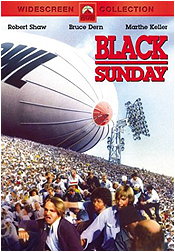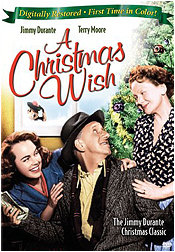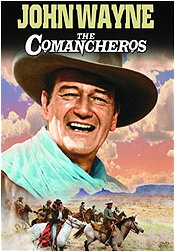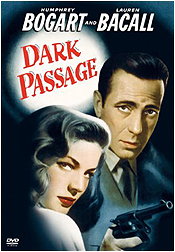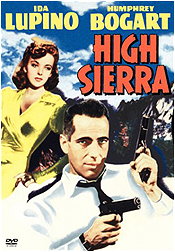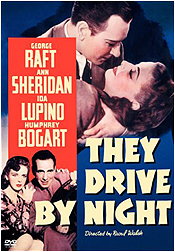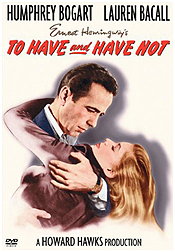 |
Site created 12/15/97.

page created: 11/28/03
 Barrie Maxwell - Main Page |
||||
| November
Review of Current Classic Releases Hello again everyone and Happy Thanksgiving, even if a day late, to all my American readers. The column this time is a catch-up one on a number of discs I've received for review. So we cover eleven discs this time out - Black Sunday and both the original and remake versions of The Italian Job from Paramount; A Christmas Wish, The Comancheros, and The Ox-Bow Incident from Fox; and Dark Passage, High Sierra, the Lon Chaney Collection, They Drive By Night, and To Have and Have Not from Warner Bros. You'll find the usual update on new classic release announcements after the reviews. Black Sunday (1976) (released on DVD by Paramount on October 14th, 2003) Middle Eastern related terrorist activities on U.S. soil may be a recent phenomenon, but the idea has piqued Hollywood's interest for some time. Almost 30 years ago, Thomas Harris's novel Black Sunday was made into a lengthy but generally satisfying film by Paramount. The story involves the efforts of the Black September terrorist group to make a statement on behalf of the Palestinian people by exploding a bomb suspended from the Goodyear blimp while it hovers over the stadium where the Super Bowl is being played. Cooperating with U.S. intelligence agencies in attempting to prevent the attack are a veteran Israeli intelligence officer who knows who the leader of the plot is. |
||||
| The
film's DVD is a bare-bones one with nary a supplement to be seen.
But at least Paramount's 2.35:1 anamorphic transfer is well up to
the company's high standard. There's a bit of grain noticeable,
particularly in darker sequences, but aside from that the image is
quite sharp and clear. Colours appear natural and are reasonably
vibrant. The original English mono track has been restored and is
really all you need to convey the story quite adequately. For good
measure, however, Paramount throws in a new Dolby Digital 5.1
surround track which adds a bit of pizzazz to the proceedings, but
won't make you want to run out and upgrade your sound systems. A
French mono track and English subtitles are also provided. A Christmas Wish (1950) (released on DVD by Fox on November 4th, 2003) A Christmas Wish was entitled The Great Rupert when it was first released over 50 years ago. The film was actually the first feature-length effort by George Pal, famous at the time for his Puppetoons produced for Paramount throughout the 1940s, and had been one that Pal had attempted to get made for several years. He generated some interest from Peter Rathven at RKO and when Rathven later left to start his own independent production company, he then signed Pal to make the film. The story concerns the Amendolas, a family of former acrobats now down on their luck, who move into an apartment where a squirrel named Rupert has taken up residence in the rafters above. Inadvertently, Rupert acts as the family's guardian angel, much to the eventual chagrin of their landlord. |
||||
| Originally
released by Eagle-Lion and now apparently controlled by a company
called Legend Films, A Christmas Wish's
DVD release comes to us courtesy of Fox. The results, however, are a
mixed blessing. We do get the film in full frame in accord with its
original 1.37:1 aspect ratio and black and white presentation. The
image transfer is pretty good with deep blacks, clear whites, and
good shadow detail, although of course there's a few speckles and
the occasional bit of debris. The mono sound that accompanies it is
in rather decent shape - little in the way of hiss or distortion -
and there are English subtitles. Somewhat surprisingly for such a
modest film, an audio commentary with one of its stars - Terry Moore
- has also been included. It's a rather chatty but not greatly
informative sort of presentation as she reacts to a film that she
hasn't seen for a long time while in the company of her son and a
clutch of people from Legend Films (who chime in from time to time).
Unfortunately, as far as I could tell, you can't hear the commentary
unless you watch the disc's other feature - a colourized version of
the film courtesy of Legend Films' staff. As colourizing goes, this
is not an unpleasant experience, but the audio commentary reveals
just how wrong they got it. Terry Moore is forever saying how much
she likes the colours chosen for the clothes she's wearing in
various scenes and then in the next breath revealing that those
colours are not those of the clothes she actually wore. This doesn't
seem to concern the Legend Films folks listening to her. To me it's
just further confirmation of how bogus colourizing actually is.
Accompanying the colourized version, if you can believe it, are both
Dolby Digital and DTS 5.1 audio tracks. Their main contribution
comprises some rather artificial-sounding directional dialogue
effects. The Comancheros (1961) (released on DVD by Fox on June 3rd, 2003) John Wayne's output was of a fairly high standard in the early 1960s with the likes of The Alamo, The Man Who Shot Liberty Valance, Hatari, and McClintock. Well up to the mark too was his work in director Michael Curtiz's final film, The Comancheros. The story begins with gambler Paul Regret killing a man in a duel in New Orleans and then fleeing to Texas to avoid arrest. There he is taken into custody by Texas Ranger Jack Cutter (John Wayne) who starts to take Regret back to Louisiana. Regret manages to escape and Cutter returns to Ranger headquarters where he soon learns that an outlaw gang has ignited an Indian attack by supplying them with rifles and liquor. Cutter is assigned to infiltrate the outlaw band and in so doing he runs into Regret again, with the two of them eventually joining forces hoping to eradicate the outlaws and destroy their desert stronghold. |
||||
The film was a Cinemascope production and Fox's 2.35:1 anamorphic DVD looks very nice indeed. Colours are very vibrant and the image demonstrates good shadow detail. A few speckles and some minor scratches are present, but edge effects are negligible. The disc shows off the western vistas of Utah to good effect. Overall, a fine job by Fox. A Dolby Digital 4.0 track gives some good depth to Elmer Bernstein's score. Also included are Spanish and French mono tracks and English and Spanish subtitles. There is some disappointment in the disc's supplements, as a very interesting and entertaining audio commentary (featuring Stuart Whitman, Patrick Wayne, Michael Ansara, and Nehemiah Persoff) that was present on Fox's previous laserdisc release is missing. We do get a short Movietone Newsreel documenting an award to the composer and singer of the film's title song and theatrical trailers in English and Spanish. There are also trailers for North to Alaska and The Undefeated. Recommended. Dark Passage (1947) High Sierra (1941) They Drive By Night (1940) To Have and Have Not (1944) (all released on DVD by Warner Bros. on November 4th, 2003) Following quickly on the heels of their admirable 2-disc DVD treatments of Casablanca and The Treasure of the Sierra Madre, WB has made Humphrey Bogart fans even more happy with this release of four of his top films of the 1940s. I suppose one could suggest that it would have been better to include another starring vehicle such as Across the Pacific or Passage to Marseille instead of They Drive By Night, but that would be quibbling. Actually these four choices provide a good opportunity to see Bogart graduate from a co-starring role typical of most of his WB films of the late 1930s to that of an enduring box-office star. |
||||
|
||||
In They Drive By Night, Bogart is once again playing a supporting role to one of the studio's stars, a situation that had become commonplace for him at WB ever since his breakthrough role there in 1936's The Petrified Forest. If it wasn't James Cagney or Edward G. Robinson, it was Bette Davis or Errol Flynn or even Pat O'Brien. This time it was George Raft who had been lured to the studio from Paramount in 1938. Raft's time at WB was not particularly auspicious for him for he had few memorable roles and seemed continually to be turning down ones that might have been. He had teamed with Bogart once previously, in 1939's Invisible Stripes which also featured a young William Holden. Now in They Drive By Night, Raft and Bogart shared screen time with two other WB up-and-comers - Ann Sheridan and Ida Lupino. This combination really clicked in the tale of Joe and Paul Fabrini (Raft and Bogart respectively) two brothers in the fruit and vegetable trucking industry who try to remain independent. Circumstances , however, lead them to work for Ed Carlsen, head of one of the large trucking businesses. There, Carlsen's wife Lana (Lupino) falls for Joe with dire consequences for all concerned. Well, they may have driven by night, but director Raoul Walsh made sure they also arrived on time. Walsh was well known for his brisk direction and staging of exciting action sequences. There were no large-scale such sequences in the film, but the smaller action bursts including several truck crashes were intense and convincing. Walsh also drew excellent performances from all four of the principals, particularly Ida Lupino who had the femme fatale role. Audiences agreed and the film was a definite success. Bogart was fine, but there was little to suggest that his tenure as a supporting player was coming to an end. But Walsh, Lupino, and Raft would all factor into Bogart's next film, one that spelt the beginning of Bogart's rise to becoming the top star of the WB lot. High Sierra was based on the new novel of the same title by W.R. Burnett. Burnett was already a well-known name in crime novel writing, with "Little Caesar" being one of his earlier successes. When WB snapped up the film rights to the new book, it wasn't Bogart they had in mind for the starring role of the aging gangster Roy Earle. Both Paul Muni (then returning to the studio after touring with the stage play "Key Largo") and George Raft were considered first, but neither in the end wanted the role, so it fell to Bogart who had expressed his interest in it from the beginning. The story of Roy Earle is that of a gangster pardoned after six years in prison. He is released into a world that he no longer relates to and finds that he has one last big job to pull. Saddled with two young punks as assistants, the planned robbery goes wrong and then the stolen goods become too hot to be of any immediate value. Roy finds himself on the run in the Sierra Nevadas with only Marie, a street-wise young woman from L.A., and a stray dog for support. The role fit Bogart to a "t" and he delivered an authoritative yet also sympathetic reading that really brought Earle to life. Ida Lupino was superb in a nice change of roles from the bitch she played in They Drive By Night. Raoul Walsh, as director, was the other carry-over from that film and he delivered another exciting, tightly controlled film that particularly took advantage of the decision to film some of the scenes on location, especially the climactic chase. Despite not being first-billed, Bogart was clearly the star of the picture and its great success with both critics and the public paved the way (with a few minor bumps along it) towards his next big success - The Maltese Falcon. By the time 1944 rolled around, Bogart was an established star with a string of successes behind him including Casablanca, Sahara, Action in the North Atlantic, and Across the Pacific. After a USO tour to the Mediterranean, Bogart returned to the WB lot to begin work on a new film that would be directed by Howard Hawks and co-star a young woman that Hawks felt showed considerable promise - Lauren Bacall. The film was To Have and Have Not, from one of Ernest Hemingway's less successful novels. The story takes place in Martinique during the Second World War and concerns Harry "Steve" Morgan (Bogart), the owner of a boat that he hires out to wealthy sportsmen. Steve is approached by Gaullist forces to smuggle in a French underground leader. At first he rejects the idea, but after he runs short of money and also wants to pay for a ticket to send Slim, a young woman (Bacall) that he has been romancing back to the States, he finally agrees. The resulting delivery of the underground representatives and its aftermath do not play out quite as planned, however. This of course is the film with the oft-cited exchange between Bogart and Bacall - "If you want me, just whistle...". The chemistry between the two was evident from their very first scenes together on the screen. Bogart looked quite comfortable in the role of Steve, and why not, it had a good deal in common with his part in a modest earlier success (something called Casablanca, I believe!). Bacall, however, was a revelation, exuding a sexual appeal that still entrances 60 years later. The two were backed up by a strong supporting cast including Walter Brennan as Eddie ("was you ever stung by a dead bee?") - a derelict that Steve has befriended, Hoagy Carmichael as a café piano player, and the familiar faces of Dan Seymour, Marcel Dalio (a Casablanca alumnus), and Sheldon Leonard. The film was a typically robust Howard Hawks effort, long on style and effectively punctuated by some well-staged action sequences and bits of comedy. The combination struck audiences just right and the film was a big success. Bogart and Bacall would appear together in three more films - The Big Sleep, Dark Passage, and Key Largo. Dark Passage is usually considered the lesser of the three, but has always been a personal favourite of mine. The story is based on a novel entitled "The Dark Road" by David Goodis and it appealed to Bogart from the beginning. It concerns a San Quentin escapee named Martin Parry who finds himself on the run with no friends to help him, save a woman named Irene Jansen who believes in his innocence. It's only through the intervention of a friendly cabby who sets Parry up with a doctor who performs plastic surgery on his face that there appears to be any future for Parry. Even with the successful surgery, Parry must deal with a blackmailer and a venomous friend of Irene's who proves to have had something to do with Parry's original conviction. One of the interesting things about Dark Passage is the fact that we don't see Bogart's face for the first half of the film. What we do see is all shown from his point of view, an approach that had also been attempted by Robert Montgomery in his filming of Raymond Chandler's Lady in the Lake the previous year. The technique is effectively handled in Dark Passage and works better than it does in Lady in the Lake simply because it doesn't persist for the whole film. The film is usually categorized as film noir and certainly the extensive use of location work in San Francisco with its overcast conditions and the simple fact that Bogart, one of film noir's iconic figures, stars in the picture make it a film noir candidate. The visual style, however, offers only an occasional nod to film noir's low-key lighting characteristic and film noir's often doomed central character is here entrapped by external forces rather than his own inadequacies. Consequently, Dark Passage seems only marginally to fit the categorization. As a Bogart and Bacall vehicle, the film is certainly a winner. It also benefits from a smashing performance by Agnes Moorehead as Irene's friend and a deliciously slimy piece of work by Clifton Young as the blackmailer. Tom D'Andrea, Bruce Bennett, and Douglas Kennedy also appear to good effect. As to Warner's work on the DVD releases, I don't believe anyone will have cause for disappointment. All four films are presented full frame in accord with the original 1.37:1 aspect ratios and all four look excellent. Yes, there is the odd speckle or scratch, but all the transfers look luminous with deep blacks, solid clean whites and nicely detailed gray scales. There are occasional instances of grain evident, but there are no edge effects. Dark Passage is the best looking of the four, but only marginally so over To Have and Have Not and High Sierra. They Drive By Night is slightly less crisp than the others. Each film sports a Dolby Digital mono track which is in great shape providing clear dialogue without attendant hiss or pops, as well as English, French and Spanish subtitles. A new making-of featurette (rabnging from 10 to 15 minutes in length) accompanies each film. All are interesting and well-presented with narration by Monte Markham, even though the content will be familiar ground for Warner Bros. aficionados. Other extras include theatrical trailers for each title, a couple of cartoons (Slick Hare on the Dark Passage disc, Bacall to Arms on the To Have and Have Not disc), a musical short subject (Swingtime in the Movies on the They Drive By Night disc), and a 1946 Lux Radio Theater Broadcast of To Have and Have Not on that film's disc. All four films are highly recommended. |
On to Part Two
Barrie Maxwell - Main Page
 |
| Site
designed for 1024 x 768 resolution, using 16M colors and .gif 89a
animation. © 1997-2015 The Digital Bits, Inc., All Rights Reserved. billhunt@thedigitalbits.com |
